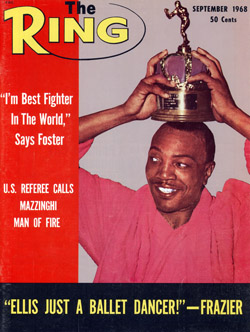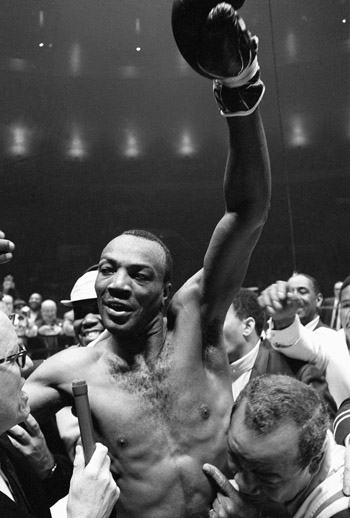Bob Foster left his mark among the best of all time


Former light heavyweight champion Bob Foster, whose iron fists ruled the division for more than six years, died Saturday morning at age 77. Though a cause of death has not yet been given, Foster had been in ill health for some time.
Although he was born in Borger, Texas, Foster was most closely associated with Albuquerque, New Mexico. It was where he grew up, where he began his amateur boxing career at age 13 (his record was reportedly 96-4 with 50 KOs) and where he worked at the police department from 1971 until his retirement in 1994. His 17-year professional boxing career saw him amass a record of 56-8-1 (46 KOs), which included victories over Henry Hank (twice), Eddie Cotton, Dick Tiger, Roger Rouse (twice), Ray Anderson, Vicente Rondon, Mike Quarry, Chris Finnegan and Pierre Fourie (twice). Foster never lost the title in the ring; he vacated the undisputed championship in September 1974, less than three months after fighting Jorge Ahumada to a controversial draw in Albuquerque.
Standing 6-foot-3 and owning a 79-inch reach, Foster’s willowy frame generated extraordinary punching power. His left hook was particularly devastating, for it produced two of boxing history’s most savage one-punch knockouts — his title-winning fourth-round flattening of Tiger in May 1968 (only Tiger’s second loss inside the distance and the sole 10-count KO defeat of the Nigerian’s 18-year, 82-fight career) and his fourth-round destruction of the previously unbeaten Quarry in June 1972.
“In the third round I told Mike, ‘Mike, that’s your last round,'” Foster said in an interview posted by the International Boxing Research Organization’s website in March 2012. “Every time I’d throw a left jab he’d slip it by leaning to his right. He’d bring his right hand back up when he returned to his normal position. I faked a jab and turned it into a hook when he came back up. Bam, I hit him right on the point of the jaw. When he went down, I couldn’t see his eyes. I thought I’d killed him.”

Photo by Herb Scharfman – Getty Images
Two of his other legacy-making knockouts included his second-round dusting of WBA titlist Rondon in an April 1972 unification fight in Miami Beach (the WBA stripped Foster for not defending against Jimmy Dupree, who Rondon stopped for the vacated belt) and his stirring 14th-round stoppage of Chris Finnegan at Wembley, which was named THE RING’s 1972 Fight of the Year.
Foster’s fists were only part of his intimidating persona. His speaking voice was a resonant bass and he was more than capable of fixing a fearsome stare. During his frequent visits to the International Boxing Hall of Fame’s induction weekend, he and former heavyweight champion Ken Norton could often be spotted at the bar of Graziano’s World Famous Inn indulging in their own private game. They would unsettle curious passersby with glares, then, after getting the reaction they were seeking, ease the tension by breaking into wide grins and chatting with them.
For all of his successes at 175, Foster also is known for his struggles when he moved up to heavyweight. He was just 4-5 against men weighing more than 200 pounds, but four of the five defeats were against high-quality foes in Ernie Terrell (KO by 7), Zora Folley (L 10), then-heavyweight champion Joe Frazier (KO by 2) and Muhammad Ali (KO by 8). The losses to Frazier and Ali were particularly memorable; Foster was knocked unconscious by one of Frazier’s trademark hooks to the jaw and while he managed to open a rare cut over Ali’s eye, “The Greatest” replied by scoring seven knockdowns. Conversely, Foster only lost three times in 44 contests staged at or near light heavyweight.
Foster’s career earned several honors: He was voted Fighter of the Year by the Boxing Writers Association of America in 1968 and was among the IBHOF’s charter inductees in 1990. He also was inducted into the original RING Magazine Hall of Fame in 1983 and the World Boxing Hall of Fame in 1984. He was named in a trio of lists compiled by THE RING; in 1994 he was rated the third greatest light heavyweight of all time while in 1996 the magazine ranked him 23rd among the “Top 50 Fighters of the Last 50 Years.” He also was rated the eighth greatest puncher of all time by THE RING in 2003.
While those rankings are subjective, his line-by-line record and the available video footage prove beyond doubt that Foster was a genuine ring immortal. While his physical body is no longer with us, the mark he left on his chosen sport will continue to resonate for all time.
Lee Groves is a boxing writer and historian based in Friendly, W.Va. He is a full member of the BWAA, from which he has won 13 writing awards, including 10 in the last five years and two first-place awards since 2011. He has been an elector for the International Boxing Hall of Fame since 2001 and is also a writer, researcher and punch-counter for CompuBox, Inc. He is the author of “Tales from the Vault: A Celebration of 100 Boxing Closet Classics. To order, please visit Amazon.com.














